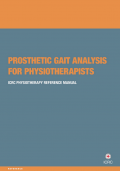Introduction
This week we are going to look in more detail at how to manage a patient with an amputation during the pre-fitting phase; this is after the acute post-surgical phase until the moment the patient is ready to be fitted with a prosthesis. You will also see how to perform a risk assessment and what type of equipment, including wheelchairs, mobility aids and prostheses, can be used and prescribed, including their application and also their advantages and disadvantages.
Objectives for this week
At the end of this week you should:
- Have a good knowledge of pre-fitting physiotherapy management techniques, including bed mobility and transfers, stump management, musculoskeletal considerations and patient education.
- Understand and discuss some of the issues relating to loss and bereavement in relation to limb loss.
- Recognise/understand the importance of carrying out a risk assessment and the inherent risk in the provision and use of specialist equipment.
- Identify and describe the different types of commonly used equipment for the rehabilitation of lower-limb amputees and discuss their application, advantages and disadvantages, indications and contraindications.
Topic 1: Pre-fitting rehabilitation phase
The aim of this topic is to give you an overview of how to appropriately manage an individual with amputation prior to their prosthetic fitting after the acute post-surgical period. Pre-prosthetic-fitting treatments aim to improve the general condition and function of the patient and prepare the stump for prosthetic fitting. You should know about transfers and functional tasks, exercises (strengthening and stretching), bandaging and scar management:
This short interview with Saeda Baraawi from the ICRC centre in Gaza discusses important aspects of pre-fitting management and criteria to aim for when sending patients for casting:
Topic 2: Pre-prosthetic exercise therapy
Below are some links to books that demonstrate many exercises that you may wish to use. You may not have time to read all these books now but having a browse through them will give you some ideas. If you would like your own copy of the Gailey books or the Engstrom book to refer to at a later date you can download the pdfs from the links at the bottom of the page.
Topic 3: Psychology and amputation
It is very important to understand and have special consideration for the psychological impact of limb loss:
Topic 4: Patient education
Patient education is important through all stages of the rehabilitation for individuals with limb loss, at this stage you might wish to consider and/or use the following resources:
Topic 5: Risk assessment:
The aim of this topic is to briefly mention risk assessment. Walking equipment should improve mobility. Nevertheless if inappropriate walking equipment is used, incorrect techniques are adopted, or if the equipment is not suitable for a particular environment, independence and safety will be compromised. It is therefore essential to carry out a risk assessment to insure the equipment is safe and suited to the patient’s needs and will not increase the risk of falls.
Risk assessment can be quite different depending on your country and working environment. Please investigate and comply with your local rules and regulations.
Topic 6: Equipment:
The aim of this topic is to review a range of equipment such as wheelchairs, manual handling equipment and walking aids (prostheses will be covered next week!).
- Read the Physiopedia page Quiz
You are not assessed on this quiz, it is designed for you to test your knowledge on the topics this week.
Case Study
Watch this video:
Discussion
Go to the Optional: Explore other resources
The following resources are optional for you to read/ but will further expand your knowledge on this week’s topics:
Prosthetic Gait Analysis for Physiotherapists
This is the course textbook from ICRC which will be available to all participants of the course.
× Como posso te ajudar?×Ola!
Como podemos ajudar?


